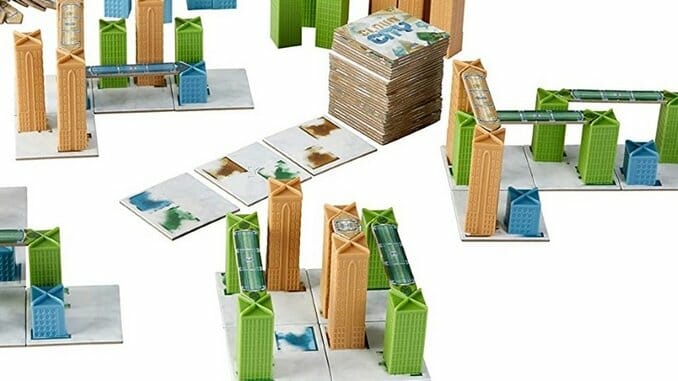
Phil Walker-Harding has had a series of hit games in the last few years, including the Spiel des Jahres-nominated game Imhotep and its spinoff Imhotep the Duel, the tile-laying games Cacao and Bärenpark, the card-drafting games Sushi Go! and Sushi Go Party!, the flip-and-write game Silver & Gold, and the easy-to-learn engine builder Gizmos. His games are easy to learn, have short turns to keep everyone involved, and usually end up revealing more depth the more you play them.
His latest game, Cloud City, hits the first two points as well as any of his games. It might be the easiest to learn of any of his games, between the mechanics and the scoring, and turns fly by; the box says 30-60 minutes but you could rip through a 2-player game in 15 minutes if you both know how to play. But there’s something missing here in the play itself, as it doesn’t have the depth of his other games, with limited player interaction and too few ways to plan ahead and try to boost your score. It sure looks great, but I can’t find the extra gear that his games tend to have.
In Cloud City, players will take tiles that each show two building spaces on them, green, blue, or brown, that correspond to plastic buildings of three different heights—all buildings of one color are the same height. (I don’t think the tiles are accessible to color-blind players.) When you select a tile, you add it to your city, which will go to 3×3 with four players and either 3×3 or 3×4 with two or three players, and then place the appropriate buildings on the tile.

You then have the choice to add walkways that connect two buildings in your city of the same color. The farther apart the buildings, the longer the walkway, and the more points it’s worth, with 8 points the maximum available. There are some restrictions: no building can have more than two walkways connecting to it, you can’t cross two walkways of the same color, and the number of walkways available is finite. The walkways share the buildings’ colors, and are limited, with just three of the 8-point walkways in each color. Walkways can go over or under walkways of different colors, which is visually appealing and can occasionally make placing them feel like a game of Operation!
Once every player has filled their city with tiles and walkways, you add up the points from your walkways and declare the winner. In the advanced variant, you take one or two of the scoring cards from the enclosed deck, which add rewards for certain things, like for creating the longest continuous chain of walkways, or can deduct points for things like building walkways that pass over other walkways.
But … that’s it. There’s very little player interaction at all here other than the competition for the limited 8-point walkways. You can’t do anything to stop another player from building anything except maybe take a tile from the display that they might want, although the benefit to that is limited because there isn’t that much variety in tiles anyway. You can plan ahead a bit to try to set yourself up to get buildings of the same side on opposite sides of your grid so that you can get the longest walkways you can, but that feels like a kids’ game.
There are things to like here—the design of the plastic buildings, the way the walkways fit into them, the very appealing look of a city with walkways crossing over and under each other in various directions—but ultimately Cloud City feels like half a game, like Walker-Harding was on to something but couldn’t find the twist to make this game meatier and more satisfying even on first play. It’s the first game of his I’ve ever tried and not liked, but I suppose we all have off days.
Keith Law is the author of The Inside Game and Smart Baseball and a senior baseball writer for The Athletic. You can find his personal blog the dish, covering games, literature, and more, at meadowparty.com/blog.